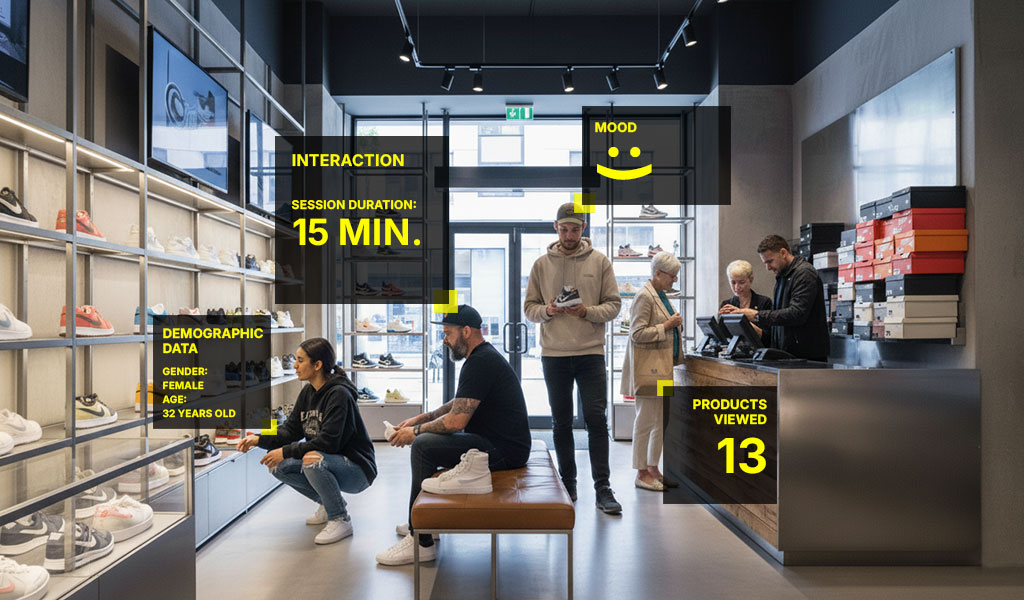
From CMS to phygital ecosystem: the evolution of Digital Signage
Digital signage is undergoing a significant evolution. In the past, it was linked to CMS (Content Management System) systems that managed content distribution. Today, thanks to Artificial Intelligence (AI) and immersive technologies that have been developed in recent years – grouped under the acronym XR (Extended Reality) – digital signage is undergoing a transformation. In this article, we will see how.
Over the last two years, Digital Signage has undergone a major transformation. It has ceased to be a simple passive reproduction of content displayed on screen and has become a bridge linking data, AI and immersive reality. An integrated ecosystem capable of combining:
- Real-time data from sensors and company systems.
- Intelligent automation to adapt content to context.
- Immersive experiences that create a point of contact between screens and the surrounding reality.
The trends identified for 2025 only confirm this direction, especially now that artificial intelligence has become an important part of our everyday lives. The trends we are talking about are:
- AI and machine learning for personalisation.
- AR/VR in retail and events to increase engagement.
- Phygital integration between the physical and digital worlds.
From traditional CMS to smart CMS
This evolution of digital signage was also driven by a powerful synergy with the world of AI, which led to a major change in the role and functionality of CMS.
It is no longer just software used to upload videos, images and text, programming the display of content schedules. We now have platforms that allow the management of complex communication flows, capable of autonomously adapting content based on the audience detected or even based on the reactions and interests that users express in real time in front of the screen.
Another feature that has made CMSs smart is the ability to define triggers during the design phase, based on which certain images or videos must be displayed. An example? If the temperature exceeds 30°C, content about cold drinks appears.
Finally, a section dedicated to data analysis and measurement KPIs has also been added. In-store traffic, dwell time and conversions are no longer a mystery, and thanks to KPI monitoring, it is possible to measure clicks, touch interactions and even integrated sales data, thereby consciously improving marketing strategies.
In short, it is no longer just a matter of setting up a playlist manager, but of learning how to manage a real decision-making engine that optimises communication in real time.
The role of Artificial Intelligence
The real star of this evolution has been AI. Techniques such as machine learning, predictive analytics and computer vision have potential that guarantees results that are difficult to achieve with manual actions, however carefully and accurately they may be performed. Below is a brief summary of all the actions that AI can perform for us, simplifying our work, ensuring greater calculation accuracy and therefore more reliable results.
- Customise content: tailor it to demographic, behavioural or environmental data.
- Predicting needs and preferences: predictive analytics enables you to show the right content at the right time.
- Optimise campaigns: algorithms automatically update playlists based on performance and objectives.
AI thus transforms communication from “broadcast” to personalised dialogue with the public, reducing operating costs: less manual intervention, more automation and greater efficiency.

XR and immersive environments
There is another branch of immersive communication that has benefited from the integration of digital signage with AI, allowing it to find increasingly widespread applications. We are talking about XR (= Extended Reality).
What do we mean when we talk about XR? We are referring to all those technologies where AI enriches the real world with virtual elements that allow people to enjoy an immersive digital experience.
The main XR technologies are:
- AR (Augmented Reality): digital content superimposed on the real world, such as smart mirrors in shops or totems that enrich the museum experience.
- VR (Virtual Reality): virtual showrooms and brand experiences that allow users to immerse themselves in an interactive environment.
- MR (Mixed Reality): phygital spaces that combine physical and digital elements, such as corporate events with interactive screens and integrated headsets.
- Interactive wayfinding: AR maps in airports or university campuses.
In this way, communication is no longer passive content but becomes an active, multi-sensory experience that engages all of the visitor’s senses, making it memorable and increasing the perceived value of the brand.
Benefits for B2B companies
The benefits of this evolution are evident in the B2C retail sector, which can offer its customers a new level of personalised customer experience. Other sectors that have greatly benefited from this evolution include:
- Automotive and real estate with the implementation of VR/AR showrooms.
- Tourism and museums with interactive tours and augmented reality.
- Corporate and events through the design of phygital environments for presentations and networking opportunities.
However, upon closer and more analytical examination, we see that the benefits of this progress also directly affect B2B environments, offering them a series of advantages that companies cannot ignore. What are they?
- Data-driven decisions: collecting user demographic data and information on how individuals interact with screens and XR technology is an invaluable resource for improving marketing strategies in a targeted and informed manner.
- New business models: immersive experiences tailored specifically for customers and suppliers can be sold as an additional service to help those who resell our product or service to convert end users.
- Competitiveness: this immersive and engaging form of communication based on AI and XR is immediately identified as futuristic and cutting-edge. These characteristics are reflected in the brand that uses them, positioning itself as innovative and distinctive.
It is therefore clear that B2B digital signage is not just a communication channel, but a strategic asset for marketing and innovation.
The future is a phygital ecosystem
Digital signage has gone far beyond displaying content on a monitor or multimedia totem. Over the years, it has become a phygital ecosystem that combines cloud content management with Artificial Intelligence and XR technologies.
Content has become smart and dynamic, adapting not only to the context but also to the demographic characteristics of the person in front of the screen and their mood. It has been possible to create triggers whereby photos, videos and experiences change in real time only when certain conditions are met.
Furthermore, XR has enabled experiences created with digital signage to expand into the real, physical world through augmented and virtual reality.
The performance of this phygital ecosystem has become measurable, with data, information and figures collected with statistical precision. Assessments and decisions are no longer guided by intuition but are data-driven, maximising the ROI of campaigns created with these technologies.
Looking ahead, the direction is clear: digital communication will become increasingly personalised, sustainable and measurable, capable of seamlessly integrating the physical and digital worlds.
